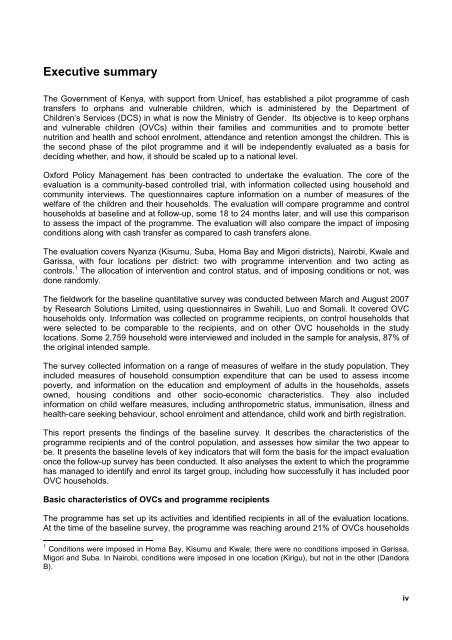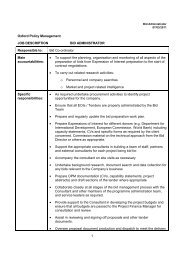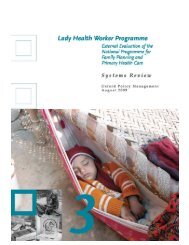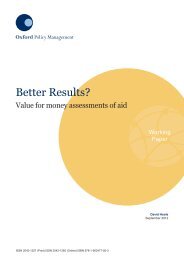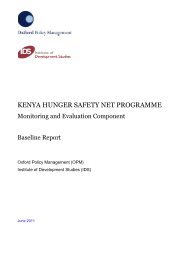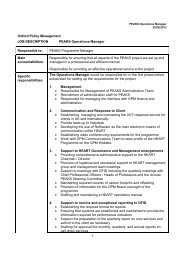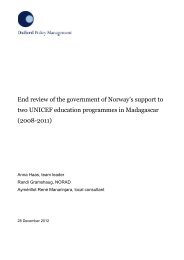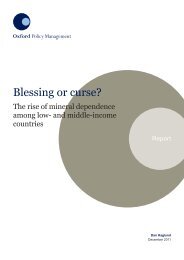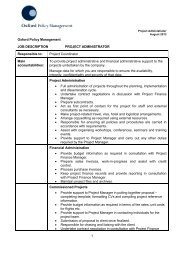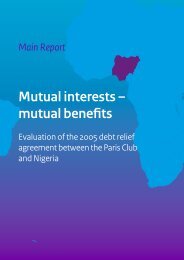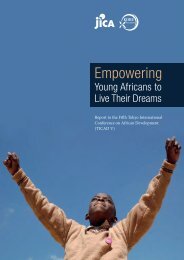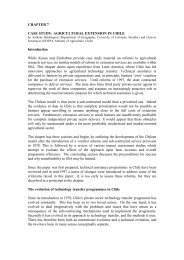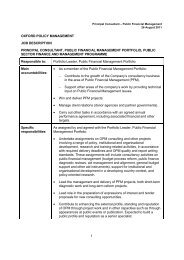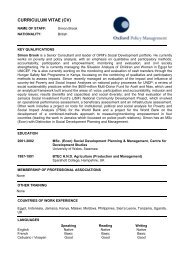Kenya OVC-CT Programme Operational and Impact Evaluation
Kenya OVC-CT Programme Operational and Impact Evaluation
Kenya OVC-CT Programme Operational and Impact Evaluation
Create successful ePaper yourself
Turn your PDF publications into a flip-book with our unique Google optimized e-Paper software.
Executive summaryThe Government of <strong>Kenya</strong>, with support from Unicef, has established a pilot programme of cashtransfers to orphans <strong>and</strong> vulnerable children, which is administered by the Department ofChildren’s Services (DCS) in what is now the Ministry of Gender. Its objective is to keep orphans<strong>and</strong> vulnerable children (<strong>OVC</strong>s) within their families <strong>and</strong> communities <strong>and</strong> to promote betternutrition <strong>and</strong> health <strong>and</strong> school enrolment, attendance <strong>and</strong> retention amongst the children. This isthe second phase of the pilot programme <strong>and</strong> it will be independently evaluated as a basis fordeciding whether, <strong>and</strong> how, it should be scaled up to a national level.Oxford Policy Management has been contracted to undertake the evaluation. The core of theevaluation is a community-based controlled trial, with information collected using household <strong>and</strong>community interviews. The questionnaires capture information on a number of measures of thewelfare of the children <strong>and</strong> their households. The evaluation will compare programme <strong>and</strong> controlhouseholds at baseline <strong>and</strong> at follow-up, some 18 to 24 months later, <strong>and</strong> will use this comparisonto assess the impact of the programme. The evaluation will also compare the impact of imposingconditions along with cash transfer as compared to cash transfers alone.The evaluation covers Nyanza (Kisumu, Suba, Homa Bay <strong>and</strong> Migori districts), Nairobi, Kwale <strong>and</strong>Garissa, with four locations per district: two with programme intervention <strong>and</strong> two acting ascontrols. 1 The allocation of intervention <strong>and</strong> control status, <strong>and</strong> of imposing conditions or not, wasdone r<strong>and</strong>omly.The fieldwork for the baseline quantitative survey was conducted between March <strong>and</strong> August 2007by Research Solutions Limited, using questionnaires in Swahili, Luo <strong>and</strong> Somali. It covered <strong>OVC</strong>households only. Information was collected on programme recipients, on control households thatwere selected to be comparable to the recipients, <strong>and</strong> on other <strong>OVC</strong> households in the studylocations. Some 2,759 household were interviewed <strong>and</strong> included in the sample for analysis, 87% ofthe original intended sample.The survey collected information on a range of measures of welfare in the study population. Theyincluded measures of household consumption expenditure that can be used to assess incomepoverty, <strong>and</strong> information on the education <strong>and</strong> employment of adults in the households, assetsowned, housing conditions <strong>and</strong> other socio-economic characteristics. They also includedinformation on child welfare measures, including anthropometric status, immunisation, illness <strong>and</strong>health-care seeking behaviour, school enrolment <strong>and</strong> attendance, child work <strong>and</strong> birth registration.This report presents the findings of the baseline survey. It describes the characteristics of theprogramme recipients <strong>and</strong> of the control population, <strong>and</strong> assesses how similar the two appear tobe. It presents the baseline levels of key indicators that will form the basis for the impact evaluationonce the follow-up survey has been conducted. It also analyses the extent to which the programmehas managed to identify <strong>and</strong> enrol its target group, including how successfully it has included poor<strong>OVC</strong> households.Basic characteristics of <strong>OVC</strong>s <strong>and</strong> programme recipientsThe programme has set up its activities <strong>and</strong> identified recipients in all of the evaluation locations.At the time of the baseline survey, the programme was reaching around 21% of <strong>OVC</strong>s households1 Conditions were imposed in Homa Bay, Kisumu <strong>and</strong> Kwale; there were no conditions imposed in Garissa,Migori <strong>and</strong> Suba. In Nairobi, conditions were imposed in one location (Kirigu), but not in the other (D<strong>and</strong>oraB).iv


